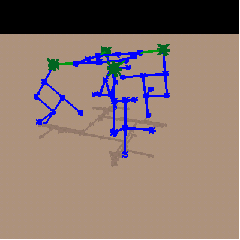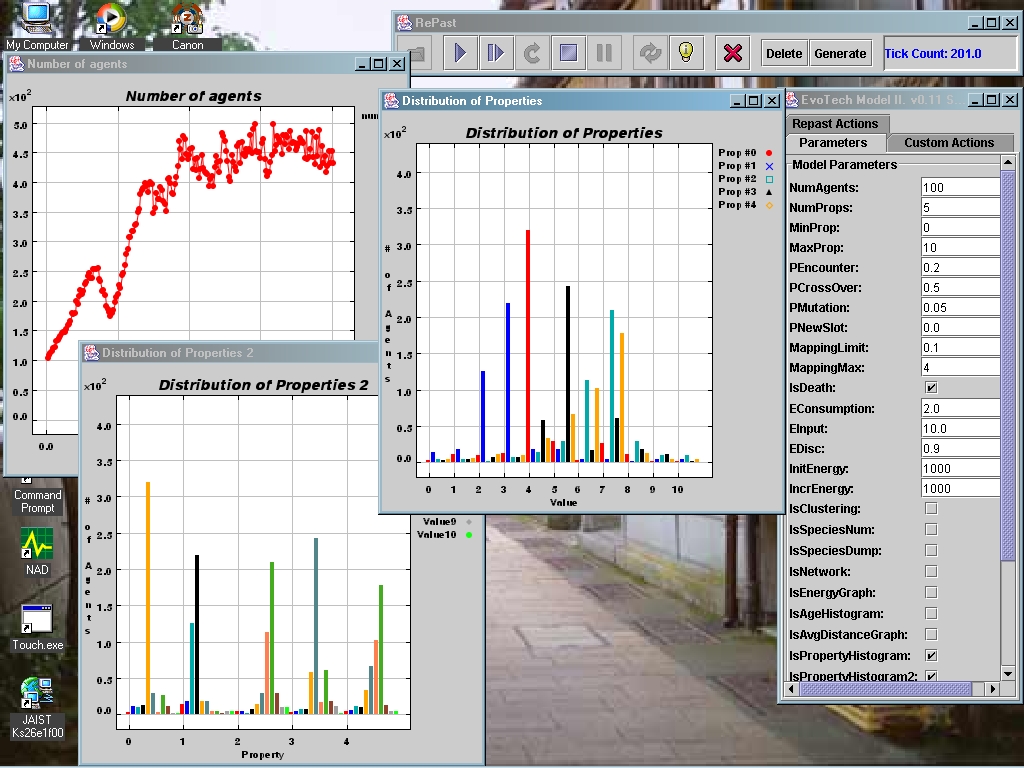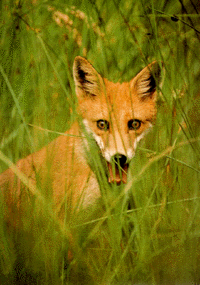A Causal Model of Evolution
George Kampis
Fujitsu Visiting Professor of Complex Systems
Japan Advanced Institute of Science and Technology
www.jaist.ac.jp/~g-kampis/
g-kampis@jaist.ac.jp
and
Chairman, Department of History and Philosophy of Science
Eotvos University, Budapest, Hungary
http://hps.elte.hu/~gk
gk@hps.elte.hu
Abstract
Evolution is more than just adaptation and selection - these, taken
alone, do not produce an open-ended process, as seen in the present-day evolutionary
simulations. Based on considerations from causality, a new model is developed,
which allows for a dynamic expansion of the selection forces active at
a given moment. In this way a sustained evolutionary process may become possible.
I present both the theory and some first, still preliminary, simulation results.
Reference: http://www.jaist.ac.jp/~g-kampis/EvoTech/ET.htm
Evolutionary Modeling: The Search for Missing Ingredient(s)
The starting point of this lecture, and of the research behind, is a critical
evaluation of the current state of the art in the modeling and the use of
evolutionary systems in biology, artificial intelligence/cognitive science,
robotics, technology and elsewhere.
The hurried should jump to my discussion of Jordan Pollack
stuff and beyond.
A more pedestrian approach should start with the question, what is
evolution.
Here are two simplified definitions of evolution, both are fairly well known.
definition 1
evolution = a (recursive) change in the genotype of a population as a result
of selection;
or, since this usually leads to a weakly or strongly
convergent process which favors the successful, we have:
evolution = adaptation by selection
definition 2
evolution = a historical process that yields new functional genotypes,
or, since a functional genotype is what makes up an
organism, and since organisms tend to form dissimilar groups of similar individuals,
we get
evolution = origin of species
Endless debates exist whether these two definitions are the same, that
is, whether Darwinian theory, which linked them first, is basically correct.
This is a topic ever since Darwin, for recent popular versions see Gould
vs Dennett.
A brief historical note. Many chapters of
Origin are about how selection and other directive forces arise as
a consequence of other factors.
In other words, Darwin's claim is not that def. 1 implies
def. 2. Rather, he forwards a complex set of claims which implies both 1&2.
In the present talk I am studying one aspect of this big issue from the
point of view of modelling, and I propose a solution (= test an idea).
Evolutionary models
Note that genetic algorithms, evolutionary programming, genetic programming
etc. apply evolution for some other purpose,
and I will not discuss them separetely. Instead, here are 3 simple steps,
beginning with the trivial. Then a 4th, summarizing.
1 - Dawkins' biomorphs system (a child's toy - indeed a childish toy -
but....)
2 - Tierra and related systems (of Tom Ray)
3 - The Golem project (of Jordan Pollack)
4 - Why is there a barrier in all these systems?
1 Dawkins' biomorphs
(here we could
take his "Wiesel applet" instead; it's slightly different but not so much)
These systems are widely available. They develop interactive
semi-fractal trees. Some example realizations are here:
http://www.well.com/~hernan/biomorphs/biomorphs.html
http://home.pacbell.net/s-max/scott/weasel.html
and an illustration is this.
The system provides iteration of hand-selected populations
with selective asexual breeding (winner-takes-all, non-overlapping generations
etc)
This may sound simple or even simplistic, yet note that it's
a non-random example:
(1) Dawinks is a non-accidental figure,
he the Chomsky of the "def1 implies def2" view
(2) biomorphs are meant as serious
examples for evolutionary programs
The Dawkins toys are suitable for helping us to a simple
point, which is this:
These programs are adaptive (and
trivially so), but not constructive/productive (of either novelty or functional
diversity).
Note that trees remain trees and never turn into
a wristwatch, which was Dawkins' own example for evolution.
2 Tierra, Core Wars and other self-breeding programs
Core War is the competiton of assembly language ("RedCode")
programs in and for memory space, in order to terminate other program's
processes.
One possible good strategy is to reproduce exponentially,
which yields something like computer viruses contained in the embedding
system.
http://mcraeclan.com/Graeme/CoreWars.htm
http://www.koth.org/
http://www.gammax.net/aiforge/game-links.htm
An illustration core dump is here.
Several attempts exist to turn this systems into an
evolution model, here is one from 1991:
http://www.soberit.hut.fi/tik-76.115/96-97/palautukset/groups/DSM/ma/documents/cwbasics.html
The breakthough was the Tierra system by Tom Ray, which is a system that
just accomplishes this goes, here you see its front-end.
Tierra is CW + self-reproduction programs + mutation,
the key was to design a mutation-friendly assembly language
http://www.isd.atr.co.jp/~ray/tierra/
Literally hundreds of similar systems exist today, such
as Avida, which is also quite well known. For one summary of these see:
http://www.biota.org/book/chbi/chbi4.htm
Okay, so what happens in these systems?
(1) competition, selection, &
differential survival lead to emergence of dominant genotypes from suitable
but otherwise random seeds
(2) famously, new "discoveries" are
made in/by these systems, such as the emergence of
faster, shorter self-replicating programs
co-operation
parasitism.
How far can we get here? Not really much further. It
is fun looking at for five minutes, or so-so for half an hour, but stops
by next morning.
The system is productive but not constructive, or not
constructive enough; new functional types emerge but not in an open-ended
way.
3 The Golem Project
An experiment in mixed software-robotic systems for
the adaptive breeding of new locomotion solutions.
Run by Jordan Pollack, http://www.cs.brandeis.edu/~pollack/
H. Lipson and J. B. Pollack (2000), "Automatic design and Manufacture of
Robotic Lifeforms", Nature 406, pp. 974-978.
R. Brooks (2000) From Robot Dreams to Reality, Nature 406, pp. 946-947
Current flagship of Artificial Life & evolution
(cum robotics) approach.
Produced several astounding results in the first phase
of the project.
 Here is an evolved creature. Some others can be seen at http://demo.cs.brandeis.edu/golem/results.html
Here is an evolved creature. Some others can be seen at http://demo.cs.brandeis.edu/golem/results.html
Yet after a point we do not get any further.
Here is a straight quotation from Pollack:
The golem@Home project has concluded. After accumulating several
Million CPU hours on this project and reviewing many evolved creatures we
have concluded that merely more CPU is not sufficient to evolve complexity:
The evolutionary process appears to be hitting a complexity barrier that is
not traversable using direct mutation-selection processes, due to the exponential
nature of the problem. We are now developing new theories about additional
mechanisms that are necessary for the synthetic evolution of complex life
forms. Some of these new mechanisms are based on ideas of modularity, regularity,
hierarchy, symbiosis and co-evolution. These ideas are resulting in a new
generation of artificial-life systems.
http://demo.cs.brandeis.edu/pr/golem/download.html
4 Why do we experience a barrier?
Fact: Sustained, open-ended evolution is not possible in currently available
simulations.
A similar complaint was recently aired also by Rod Brooks,
R. Standish and several others.
Looking for the reasons, we enter a murky territory, however.
Part of the discussion is concerned with the old-new
(pseudo-)philosophical debate about novelty.
I only give you a glimpse of that here.
"Can anything ever be new?" -is the question.
There are two views.
(1) Yes; the unconceived children that have no name and no identity are not
defended even by the Pope.
They just don't exist by any standards. Nor do future
species. Evolutionary models should incoroporate a similar ability,
that of coming up with something radically new.
(2) No;
it's always just known combinations of known elements (including your possible
children with all other men/women).
Evolution models should explore the space of combinations
more efficiently.
And so the debate is on, between the "emergence" and
the "combinations" schools, with no end in sight.
Here is an alternative approach.
Suppose there is something that natural evolution possesses,
but these models don't (or else why dont't they work?)
If we can suggest a candidate for that missing factor,
this might help overcome or understand the problem.
The suggestion that I will forward here is based on
the notion of causality.
My diagnosis-plus-suggestion is simple:
Present-day evolutionary models "run out of steam" because they assume
that definition1 implies definition2.
What actually happens, then, is that selection behaves in/for these systems
like an input resource which is only consumed and finally depleted.
When that point is reached, further development stops.
Similar to the robot's dilemma: "what to do next?".
Ford, K., and Z. Pylyshyn, Eds. (1996).
The Robot's Dilemma Revisited. Norwood, NJ: Ablex.
Pylyshyn, Z., Ed. (1987). The
Robot's Dilemma. Norwood, NJ: Ablex.
The idea now is that causal processes can imply both definitions 1&2,
much as in Darwin's original theory.
Causality, properly uinderstood, has the role to give a kick to the evolutionary
process when it's about to halt.
A Causal Model of Evolution
1 - Causality
2 - The role of causality in (co) evolution
3 - A new evolutionary model
1 Causality
The understanding of causality is crucial for science in general (and,
as I suggest, evolution in particular).
An intuitively clear concept, yet there is considerable difficulty in its
characterization.
Some candidates:
- "function" (B. Russell) - but it can boil down to mere correlation
(E., Sober, contra Reichenbach and others)
- counterfactual dependence (if not A then not B) to express
"A evokes B", but subject to same problem: maybe correlation
- manipulability of B by A - different idea, note that it
is no more formal! an anthropocentric definition, how about nature?
- depth:
Causality is a relationship between
(the occurrence of) events which involves more events of a different type
for which the same (i.e. an equivalent)
relation holds.
Of special interest is not in causal chains (i.e. temporally
disjoint sets of consequences), but in the existence of simultaneous causal
relations.
C1 R1 E1
C = cause R = relation E = effect
always involves
C2 R2 E2
.. . .. . .. .
.. . .. . .. .
Cn Rn En
such that R1 holds iff R2......Rn holds
A simple example is causality occuring in static supervenient
levels.
For isntance, taking medicine to heal an illnes "is
the same" as blocking receptors to fend off antigens.
These are different ways of approaching "the same phenomenon"
- in fact NOT the same phenomenon but the same, but deep, causal relation.
Supervenience is only one example. It has asymmetric
dependence bw constituing relations,a fixed number (typically 2) of layers
such as molecular/mental etc.
Usually, causal relations connected by depts are more
symmetrical.
Depth is a modal (indexical) property - which is strictly
speaking an euphemism for "implicit", "hidden", "tacit", "contextual", or
"non-formal".
But, then, causality has never been entirely formal.
Judea Pearl (2000):
Causality, Models, Reasoning, and Inference, Cambridge U. Press.
Ian Hacking (1983):
Representing and Intervening, Cambridge University Press.
2 The role of causality in (co) evolution
What here follows is a hypothesis when coming to details, but it begins
with plain enough facts. Here is one.
Evolution is just co-evolution.
Co-evolution = mutual depencence of biotic selection
forces (e.g. host - parazyte relations).
Co-evolution occurs in every ecosystem
Van Valen 1973
Stenseth and Maynard Smith 1984
In short, selection forces in natural evolution are (very often) biological,
being themselves evolutionary products (this goes back to Darwin).
(Nobody denies this, as far as I can tell, but it is suprisingly difficult
to find works about just that...., except maybe buddhist etc. stuff)
Illustration 1,
Deliberately taking what (at surface level) may look
like physical adaptation:
white rabbit fur in the Arctic. This is a result of
a multi-step adaptation process induced by migration from southern predators,
hence,
it is an adaptation to these predators.
Illustration 2
In Tierra-like systems, adaptation to other programs,
e.g. co-operation, occurs in response to a "ceteris paribus" presence of
other, evolved, programs.
My suggestion is to make causality (i.e. causal depth) responsible for
the evolutionary origin of selection forces.
The idea is that adaptation changes properties (in step 1) which, in turn,
changes interactions (in step 2), allowing for the iteration of (1 &2).
Step 1, adaptation, influences several causal
"layers".
A cause-effect relation triggered by cause Ci
evokes events E1...... En because of the "depth"of the causal interaction.
Some of these (Ej) can trigger further events,
e.g. when certain thresholds are crossed.
That is, adaptation in one species can "turn on"
new selection processes concerning other species.
Sustained evolution is causal evolution.
Consider a fox - hedgehog - parasitic insect ecosystem.
Foxes move into a territory, exert pressure on small
hogs, which develop thorns, providing new shelter for mites & fleas,
which increase in numbers
and adapt to their new enviroment.
(There are several crude simplifications here, as in
every other popular bedtime tale of evolution. Let us now keep to these simplifications.)
foxes move in
----------------------------
>
------------------------- event that thorns appear *
----------------------------
....
----------------------------
.....
----------------------------
------------------------- thorns provide cavities between
> ------------------------ fleas catch up
dynamics1
>
dynamics 2
(selection equation)
(population dynamics and possibly selection)
- by the asterisk I remind the reader that this is shorthand for a complicated
sequence of events.
3 A new evolutionary model
A new computer model is being developed and tested by us, which incorporates
causal ideas of (co)evolution.
We call it a work in evolutionary technology, mainly to free ourselves
from many biological details.
There is but one rule: To obtain open-ended evolution, anything goes,
as long as it does not crash your hard disk.
The goal is to develop a system capable of such sustained evolution.
Work in cooperation with L. Gulyas - PhD student
http://www.sztaki.hu/~gulyas/indexE.html
- was at Government Department and
Center for Basic Research in the Social Sciences (CBRSS), Harvard
- worked with Lars-Eric Cederman
- background on Java and Java based
development in basic research and AI.
Need: "digital organisms" that
interact
reproduce / mutate
/ have crossover
undergo property-
(i.e. phenotype-) based selection
maintain variable
length records for phenotype encoding
can switch interaction/selection
at given thresholds
Agent-based modelling and simulation technology:
a generative simulation
method, the current version of "artificial worlds" approach that exists
since 1970 (M.Conrad, Wayne State)
RePast system,
U. Chicago; SWARM-like but for social simulations, supports permeable, mutually
defining agents
in the agent setting,
selection can be freed from nonfunctional (e.g. spatial) constraints byproducts
of other software models.
Realization details
Organisms have a list of properties ("slots") that can take on values.
Properties (ie. phenotypic traits) are heritable and don't change during
lifetime, but are not represented in separate genes
(or take 1-1 mapping between gene and trait).
There are three kinds of events: random mating and random nutrition, and
random change of slots (addition/deletion).
Mating means sexual reproduction, based on the similarity distance between
two phenotypes. The number of offspring is funtion of this distance.
The event of mating is composed of: encounter, sprawning of offspring(s),
mutation, and crossover.
Feeding is similarity distance dependent between "predator and prey".
Organisms have a lifetime, which feeding extens with a progressively discounted
value.
In other words, this is a phenotype (i.e.interactor) based selection model
with two kinds of selection: sexual and eliminative.
The idea is to develop species which change: split up into several, functionally
different species in the presence of new slots, but not without.
But first we wanted to test if the model is suitable as an evolutionary
model at all.
Interface: Control and Display

The picture also shows a sample run in which one species emerges. A longer
run is here.
Questions
1 - Will it work at all?
Get any meaningful
behavior? Collapses or runaways threaten in various ways.
A technical detail
here: a system which is expected to evolve multiple species cannot conserve
energy... so, guess....
2 - Can we get stable species?
Not a trivial
question, again.
We know of no
other evolutionary simulation with changing phenotype space and with feedback
from phenotype to the selection force.
Technically, variable
length records can (and sometimes do) make the selection process crash.
3 - Can we develop new species? New ecology?
Of course, the
answer strongly depends on what we mean by species. So let us reformulate
the question:
Can we get stable
distribution of values over the slots, despite the slot composition changing?
Can a stable distribution
be turned multi-modal afterwards?
Can a multi-modal
distribution allow for new selective events?
4 - Can we get sustained evolution this way?
If the answer
to 3 is positive, how may times can we repeat the procedure? Is open-ended
evolution possible?
Some preliminary results
So far we have some partial answers.
1 - Yes. The model clearly works and shows basic features expected from
every evolutionary model.
E.g. Fisher's theorem, stabilizing
selection vs drift, etc etc.
2 - Yes. In a minimal ecosystem, the model can produce stable species in
a very wide range of parameters.
e.g.: Mutation
rate bw. 0 and 0.3
New slot rate bw. 0 and 0.1
Energy consumption and energy discount rates 1-10 and 0.8 to 0.99,
respectively.
3 - Probably yes. On paper it works already :-))
The principle is that a property
record of a given length allows for the functioning, but not for emergence
of multiple species,
defined as stable value distributions over the slots.
4 - The long-term target of the research.
Where to go from here?
1 - theory causal feedback, niche construction, competition
avoidance - very strongly underdeveloped field.
one major publication is
Laland, K.N./Odling-Smee, F.J./Feldman, M.W. 1999.
Niche construction, biological evolution and cultural change.
Behavioral and Brain Sciences 23: 131—175.
2 - experiments get 3 & 4




 Here is an evolved creature. Some others can be seen at http://demo.cs.brandeis.edu/golem/results.html
Here is an evolved creature. Some others can be seen at http://demo.cs.brandeis.edu/golem/results.html



